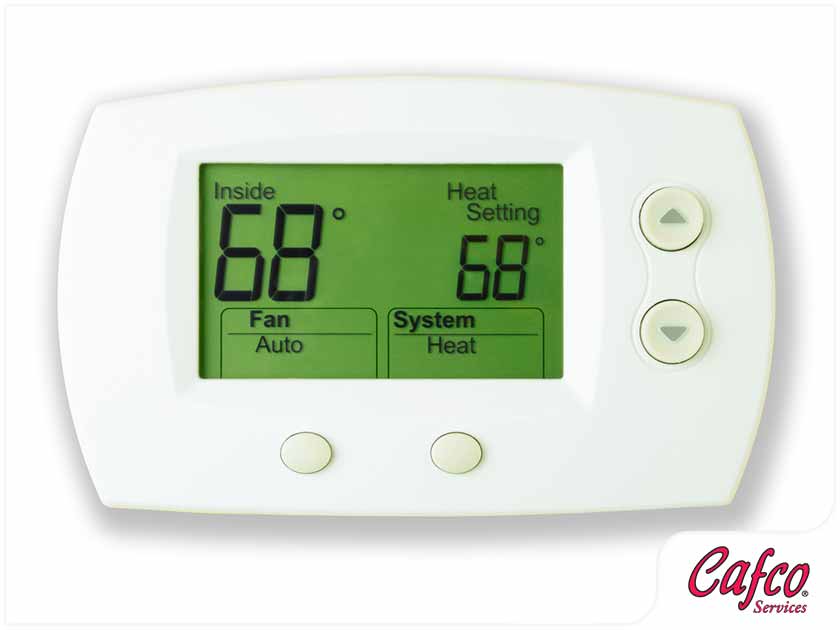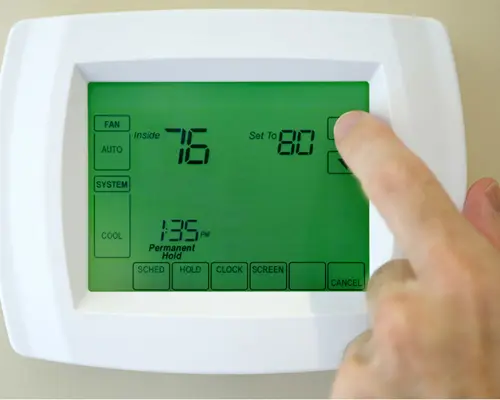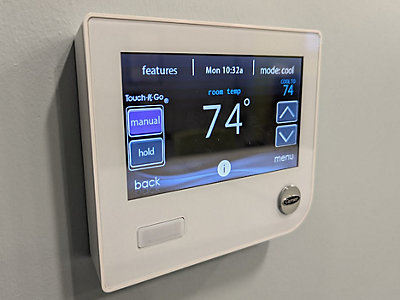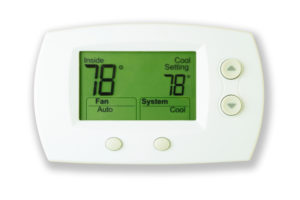Check Best Thermostat Pricing in Amazon
** As an Amazon Associate, I earn from qualifying purchases.
The “Auto” setting on a thermostat can be confusing. It’s a feature many of us see but may not fully understand.
The “Auto” function on a thermostat controls your HVAC system efficiently. It lets the system decide when to heat or cool based on the current temperature. This setting helps maintain a stable and comfortable indoor environment. With “Auto,” you don’t need to adjust the settings constantly.
The thermostat does the work for you. This not only ensures your home stays comfortable but also helps save energy. Understanding this feature can make managing your home’s climate much easier. So, let’s dive deeper into what “Auto” means and how it can benefit you.
Auto Mode Basics
The Auto Mode on your thermostat is a handy feature. It helps maintain a comfortable temperature in your home. Understanding its basics can help you make the most of your thermostat. Let’s delve into the details.
Purpose Of Auto Mode
The main purpose of Auto Mode is to automate temperature control. It adjusts heating and cooling without manual intervention. This ensures a steady and comfortable indoor climate.
Auto Mode saves energy by optimizing system performance. It turns on the heating or cooling only when needed. This helps in reducing energy bills and extending the life of your HVAC system.
How It Works
Auto Mode uses temperature sensors to monitor indoor conditions. These sensors detect when the temperature rises or falls outside the set range. The thermostat then signals the HVAC system to start heating or cooling.
For instance, if the room gets too warm, the cooling system kicks in. If it gets too cold, the heating system takes over. This automatic switching maintains the desired temperature range.
Auto Mode also adjusts the fan settings. The fan runs only when needed, further saving energy. This mode ensures your home remains comfortable without frequent manual adjustments.

Credit: www.cafcoservices.com
Benefits Of Auto Mode
Understanding the benefits of Auto Mode on your thermostat can make a significant difference in your home’s comfort and energy savings. Many people overlook this feature, but it can be a game-changer in managing your heating and cooling systems efficiently. Let’s dive into how Auto Mode can help you achieve energy efficiency and consistent comfort.
Energy Efficiency
Auto Mode optimizes your thermostat settings to reduce energy consumption. When I first switched to Auto Mode, I noticed a drop in my energy bills almost immediately. The system adjusts the heating and cooling based on real-time indoor conditions, ensuring the system runs only when needed.
This means your HVAC system isn’t running all the time, preventing unnecessary energy use. Imagine coming home to a perfectly balanced temperature without having to fiddle with the thermostat. Auto Mode does the thinking for you, making it easier to maintain an energy-efficient home.
Consistent Comfort
Maintaining a consistent temperature in your home is crucial for comfort, especially during extreme weather. Auto Mode helps achieve this by constantly monitoring and adjusting to your preferred settings. I’ve found that my living space remains comfortable without any hot or cold spots.
Think about those chilly winter mornings. With Auto Mode, your thermostat ensures your home is warm when you wake up, without having to manually adjust the settings. This feature provides peace of mind and a consistent living environment.
Have you ever wondered how much time you spend adjusting your thermostat? Auto Mode can save you time and effort, allowing you to focus on more important things. It’s a simple change that can enhance your everyday life.
Comparing Auto And Manual
Understanding the differences between auto and manual settings on a thermostat can help you manage your home’s temperature more efficiently. Both settings have unique features that cater to different needs and preferences.
Control Differences
The auto setting on a thermostat automatically adjusts the temperature based on the set point. It turns the heating or cooling system on and off to maintain the desired temperature. This means less manual intervention is needed.
In contrast, the manual setting requires you to adjust the temperature yourself. You control when the system turns on and off. This gives you more direct control, but it can be less convenient.
Pros And Cons
The auto setting offers convenience and energy efficiency. It reduces the need for constant adjustments and helps maintain a consistent temperature. This can lead to lower energy bills.
However, some users may feel a lack of control with the auto setting. They may prefer the flexibility of manual adjustments. The manual setting allows for immediate changes but may result in higher energy use.
Setting Up Auto Mode
Setting up the auto mode on your thermostat can be a game-changer for maintaining a comfortable temperature in your home. This feature automatically switches between heating and cooling to keep your home at the desired temperature. Let’s dive into how you can set it up and troubleshoot common issues.
Initial Setup
First, locate the auto mode on your thermostat. This option is usually found under the main menu or settings.
Select auto mode and set your desired temperature range. For example, you might choose 68°F for heating and 75°F for cooling.
Make sure your system is compatible with auto mode. Some older models may not support this feature.
Troubleshooting Tips
If your thermostat isn’t switching between heating and cooling, double-check your temperature settings. Ensure there’s a clear difference between the heating and cooling points.
Check if your thermostat needs a firmware update. Manufacturers often release updates to improve functionality.
If your system still isn’t working, consult the user manual or contact customer support. They can offer specific advice for your model.
Have you ever set up auto mode on your thermostat? What challenges did you face, and how did you overcome them?
Setting up auto mode can take a bit of trial and error, but the comfort and convenience it offers are worth it. Enjoy a perfectly balanced home temperature without the hassle of constant adjustments.
Check Best Thermostat Pricing in Amazon
** As an Amazon Associate, I earn from qualifying purchases.
Advanced Features
Advanced features in thermostats offer more control and convenience. These features make managing your home’s temperature easier and more efficient. Let’s explore some of these advanced options.
Smart Thermostats
Smart thermostats are intelligent devices. They learn your habits and adjust the temperature automatically. These thermostats save energy and reduce utility bills. They can even adjust settings based on the weather forecast. Smart thermostats are an excellent investment for a modern home.
Remote Access
Remote access allows you to control your thermostat from anywhere. Use a smartphone or tablet to adjust the temperature. This feature is useful for those with unpredictable schedules. Forgot to turn off the heat? No problem. Just open the app and make the change. Remote access adds convenience and peace of mind.

Credit: www.ars.com
Auto Mode In Different Seasons
Understanding the auto mode on your thermostat is key for year-round comfort. Auto mode helps maintain a consistent temperature, adapting to different seasons. Let’s explore how auto mode works during summer and winter.
Summer Settings
In summer, the auto mode keeps your home cool. It ensures the air conditioner runs when temperatures rise above your set point. This prevents overheating and maintains a pleasant indoor climate. The thermostat automatically adjusts, ensuring energy efficiency. You won’t need to manually switch between cooling and heating modes.
Winter Settings
In winter, the auto mode focuses on heating. It activates the furnace when temperatures drop below your set point. This keeps your home warm and cozy, preventing the chill. The thermostat adjusts automatically, providing consistent warmth. It also helps save energy by avoiding unnecessary heating cycles.
Common Misconceptions
When it comes to setting your thermostat, you might have noticed an “Auto” mode option. This setting often leads to confusion and misconceptions. Let’s clear up some of these misunderstandings to help you get the most out of your thermostat.
Myths About Auto Mode
One common myth is that “Auto” mode means the thermostat will automatically adjust the temperature based on the time of day. This is not true. “Auto” mode simply controls the fan, turning it on when heating or cooling is needed and off when it isn’t.
Another misconception is that “Auto” mode will save you money on your energy bills. While it can help, it’s not a guarantee. The efficiency of “Auto” mode largely depends on your home’s insulation and your HVAC system’s condition.
Some people believe that “Auto” mode will provide immediate comfort. However, it might take a few minutes for the system to adjust to your desired temperature. Understanding this can help you manage your expectations.
Clarifying Facts
The “Auto” setting on your thermostat regulates the fan operation. It turns the fan on only when the system is actively heating or cooling. This can help reduce energy consumption.
Using “Auto” mode can extend the life of your HVAC system. By running the fan only when necessary, you reduce wear and tear on the system. This can lead to fewer repairs and longer-lasting equipment.
You might wonder if “Auto” mode is the best setting for your home. It often is, but it’s essential to consider your specific needs. If you prefer continuous air circulation, the “On” mode might be better for you.
Have you tried different settings on your thermostat? Share your experiences in the comments. Your insights could help others make better choices for their home comfort.
User Experiences
Understanding the “Auto” setting on a thermostat can be confusing. Users share mixed feelings and experiences. Let’s explore some real-life testimonials and expert opinions.
Testimonials
Jane from Texas says, “I love the Auto setting. It keeps my home comfortable. I don’t have to adjust it often.”
Mike in New York shares, “The Auto mode is convenient. But sometimes, I feel it takes too long to adjust.”
Emma from California notes, “Auto is great for energy savings. My bills are lower now.”
Expert Opinions
John Smith, an HVAC technician, states, “Auto mode helps maintain a steady temperature. It’s efficient and cost-effective.”
Sarah Johnson, a home energy expert, says, “Using Auto can optimize your system’s performance. It reduces wear and tear.”
Dr. Emily Brown, an environmental scientist, believes, “Auto settings are better for the environment. They reduce energy consumption.”

Credit: buckeyeheat.com
Frequently Asked Questions
Should Thermostat Be On Auto Or On?
Set your thermostat to “auto” for better energy efficiency. It adjusts heating and cooling based on the temperature.
Is It Better To Leave Ac On Or Auto?
Using the “auto” setting on your AC is generally better. It adjusts the temperature more efficiently, saving energy and reducing costs.
What Is Auto On And Off On A Thermostat?
Auto on and off on a thermostat automatically controls heating or cooling to maintain your desired temperature. It saves energy.
What Does Auto Mean On A Thermometer?
“Auto” on a thermometer means it automatically turns on or off based on temperature changes. This feature saves battery.
Conclusion
Understanding the “Auto” setting on your thermostat can save energy. This setting adjusts the heating or cooling based on your temperature preference. It helps maintain a comfortable home environment. Use it to avoid manual adjustments and reduce energy costs. Experiment with settings to find the best fit for your home.
Check your thermostat manual for specific details. Adjusting correctly can enhance comfort and efficiency. Feel free to share your experiences or ask questions about your thermostat settings.
Check Best Thermostat Pricing in Amazon
** As an Amazon Associate, I earn from qualifying purchases.


